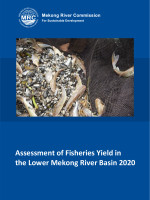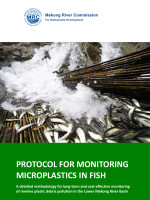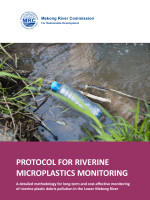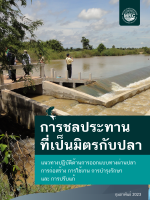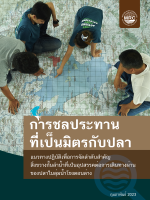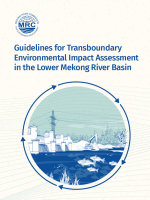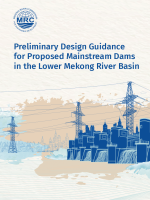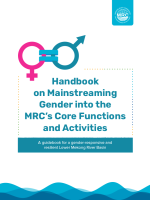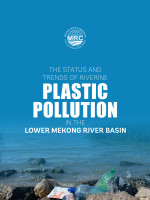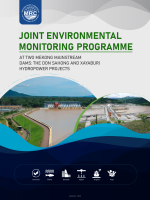Publications related to Fisheries
Assessment of fisheries yield in the Lower Mekong River Basin 2020
MRC conducts periodic assessments of fisheries yield in different regions of the Lower Mekong Basin ):MB) to inform policy decisions and understand trends in catches and the value of aquatic living resources over time. The assessments conducted in 2020 suggest that the annual finfish yield from the LMB falls within the range of 1.51 to 1.71 million tonnes, while the harvest of other aquatic animals (OAA) is approximately 443,000 tons. These findings reveal a considerable decline in catches, amounting to approximately 25-30%, compared to the assessments conducted in 2000 and 2010. The estimated value of the fish catch varies from USD 7.13 billion to USD 8.37 billion annually. In addition, the estimated value of the OAA harvest is approximately USD 1.13 billion.
Download | DOI: 10.52107/mrc.bivw7w | Published on: 05 Feb 2024 | Language: English
Protocol for Microplastic Monitoring in Fish
A detailed methodology for long-term and cost-effective monitoring of riverine plastic debris pollution in the Lower Mekong River Basin
With a recent study identified the Mekong River as one of ten rivers to contribute over 90% of plastic debris to the world’s marine environment, there is an urgent need for a reliable data and information on riverine plastic debris pollution and their impacts to the aquatic environment of Mekong River. This Protocol for Monitoring Microplastic in Fihs has been developed and finalized as one of three protocols of the MRC’s Detailed Methodology for the Long-term and Cost-effective Monitoring of Riverine Plastic Debris Pollution in the Lower Mekong River Basin (LMB). The finalization of the detailed methodology was made possible through the concerted efforts and commitment of the MRC Member Countries and support of experts at national, regional and global levels, and included rigorous processes of consultations, capacity building, and piloting to ensure that the methodology is adapted to the situation of the LMB. The methodology aims to provide the much-needed data and information for an improved knowledge and understanding on the pathway and behaviors of plastic debris pollution in the LMB, from land-based sources to riverine environment, and ultimately to the marine environment. Information derived from the long-term implementation of methodology can be used to assess the effectiveness of plastic waste management the LMB.
Download | DOI: 10.52107/mrc.bhv7va | Published on: 19 Jan 2024 | Language: English
Protocol for Riverine Microplastics Monitoring
A detailed methodology for long-term and cost-effective monitoring of riverine plastic debris pollution in the Lower Mekong River
With a recent study identified the Mekong River as one of ten rivers to contribute over 90% of plastic debris to the world’s marine environment, there is an urgent need for a reliable data and information on riverine plastic debris pollution and their impacts to the aquatic environment of Mekong River. This Protocol for Riverine Microplastic Monitoring has been developed and finalized as one of three protocols of the MRC’s Detailed Methodology for the Long-term and Cost-effective Monitoring of Riverine Plastic Debris Pollution in the Lower Mekong River Basin (LMB). The finalization of the detailed methodology was made possible through the concerted efforts and commitment of the MRC Member Countries and support of experts at national, regional and global levels, and included rigorous processes of consultations, capacity building, and piloting to ensure that the methodology is adapted to the situation of the LMB. The methodology aims to provide the much-needed data and information for an improved knowledge and understanding on the pathway and behaviors of plastic debris pollution in the LMB, from land-based sources to riverine environment, and ultimately to the marine environment. Information derived from the long-term implementation of methodology can be used to assess the effectiveness of plastic waste management the LMB.
Download | DOI: 10.52107/mrc.bh5hvu | Published on: 19 Jan 2024 | Language: English
Fish-Friendly Irrigation: Fishway Inspection Manual (Thai)
The Fishway Inspection Manual focuses on assessing design and requirements for maintenance of fishway as a complementary document of the Fishway Guidelines for Irrigation Facilities. The Manual is intended to be used for practitioners on-site with the Fishway Guidelines.
Download | DOI: 10.52107/mrc.bi64hi | Published on: 23 Feb 2023 | Language: Thai
Fish-Friendly Irrigation: Guidelines to Prioritising Fish Passage (Thai)
The ‘Guidelines to Prioritising Fish Passage Barriers’ provides a concise method to identify the highest priority barriers for installing fishways on irrigation facilities in a selected catchment. The method is based on physical, biological and socio-economic considerations, and uses remote sensing tools and analysis to assess and rank large numbers of barriers.
Download | DOI: 10.52107/mrc.bi64gf | Published on: 22 Feb 2023 | Language: Thai
Guidelines for Transboundary Environmental Impact Assessment in the Lower Mekong River Basin (TbEIA)
The Guidelines for Transboundary Environmental Impact Assessment in the Lower Mekong River Basin (TbEIA) is designed as a flexible document with perspective of its further elaboration based on gradually accumulated experience of Member Countries with a TbEIA application. It is also designed as a supporting tool applicable with respect to the different national EIA legislation systems in Member Countries. It builds on and supplements five MRC procedures, including the Procedures for Notification, Prior Consultation and Agreement; Procedures for Data and Information Exchange and Sharing; Procedures for Water Use Monitoring; Procedures for Maintenance of Flows on the Mainstream, and Procedures for Water Quality in addressing potential transboundary environmental impacts of development projects.
Download | DOI: 10.52107/mrc.aqrsbk | Published on: 20 Feb 2023 | Language: English
Preliminary Design Guidance for Proposed Mainstream Dams in the Lower Mekong River Basin (PDG)
The new Preliminary Design Guidance is an updated version of the original PDG introduced in 2009. It incorporates not only what the MRC Member Countries have learnt from their own experience with hydropower, but also from examples and best practices around the world. It also includes the most current knowledge regarding design criteria, science and technology. While the older PDG spanned this range of construction and operation elements (hydraulics; sediment transport; geomorphology; water quality; aquatic ecology; fish and fisheries; dam safety; and navigation), the new PDG now includes hydrology and socio-economic impact to reflect the greater attention paid today to riparian communities and riverine livelihoods.
Download | DOI: 10.52107/mrc.ajutqi | Published on: 20 Feb 2023 | Language: English
Handbook on Mainstreaming Gender into the Mekong River Commission’s Core Functions and Activities: A Guidebook for a Gender-Responsive and Resilient Lower Mekong River Basin
The Handbook for Gender Mainstreaming into the MRC Core Functions and Activities offers a supporting tool – or a guiding note – to assist the MRC to effectively integrate a gender perspective into all aspects of its work, from the development, update and application of strategic tools, procedures, normative guidelines, studies, and organizational strengthening to designing and advocating for joint actions. It also provides a working aid to integrate gender perspectives during the course of the BDS 2021–2030 and SP 2021-2025 implementation, and beyond
Download | DOI: 10.52107/mrc.ajutqn | Published on: 30 Dec 2022 | Language: English
The status and trends of riverine plastic pollution in the Lower Mekong River Basin
This report explains the status and trends of plastic waste pollution in the Lower Mekong River Basin from the perspectives of plastic pollution itself as well as the frameworks and capacity of each Member Country to address the issues of plastic pollution. The report estimates that in 2020, its four countries had produced about 8 million tons of plastic waste – of which, some 70% to 90% were plastic bottles, plastic bags and Styrofoam. Yet this debris does more than adversely affect the Mekong and its tributaries.
Download | DOI: 10.52107/mrc.aqrsb2 | Published on: 19 Dec 2022 | Language: English
Joint Environmental Monitoring Programme at Two Mekong Mainstream Dams: The Don Sahong and Xayaburi Hydropower Projects
The report provides an overview of activities conducted and resulting recommendations from monitoring two mainstream dams: Don Sahong and Xayaburi hydropower projects. It summarizes the pilot monitoring results from the first pilot site report for each hydropower project and the Combined Annual Report in a way that illustrates how findings in hydrology, sediment, water quality, aquatic ecology, and fisheries can be interpreted together. Based on the findings, it provides some initial suggestions for mitigation and adaptive management of construction and operation of hydropower projects. It also concludes with recommendations for revisions to the guidelines and monitoring protocols that can then be incorporated into the JEM Programme document.
Download | DOI: 10.52107/mrc.aqrs7o | Published on: 19 Aug 2022 | Language: English
